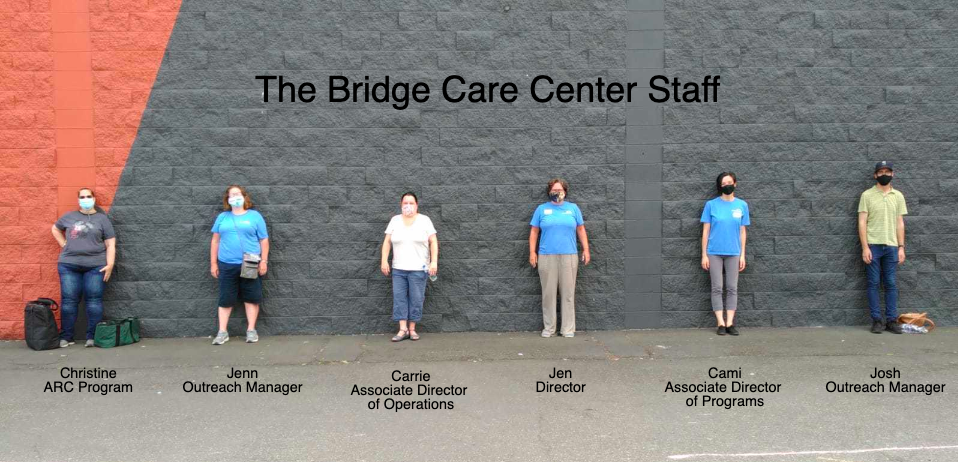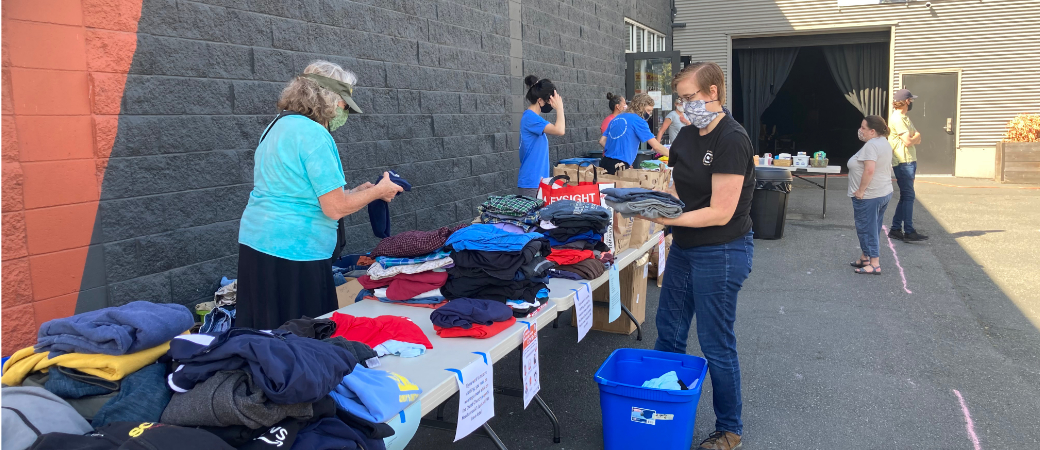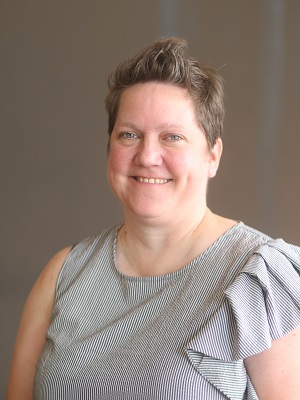
By Jen Manlief, Director, The Bridge Care Center, A Ministry of Quest Church
The Bridge Care Center is a drop-in day center in the Ballard neighborhood of Seattle and an affiliate ministry of Quest Church; our mission is to be a bridge to resources, relationships, and hope for women and men experiencing homelessness or economic hardship in Ballard. Until March of this year, pursuing our mission looked like hosting open hours at our building where our neighbors could pick new outfits from our clothing closets, use computers and phones, meet with an outreach manager, eat doughnuts in our community room while watching a movie, and most importantly, be known by name and story by The Bridge staff and volunteers. But then COVID-19 entered our reality, and Seattle shut down. Our last day of open hours was March 17.
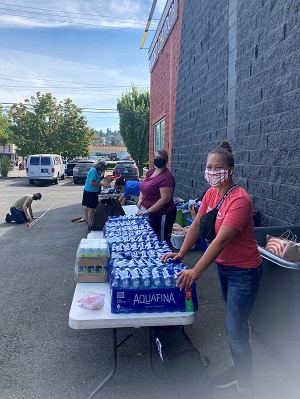
During the next two weeks of self-isolation by our staff due to potential exposure to COVID-19 from a neighbor who was awaiting test results, we got the hang of staring at ourselves in Zoom meetings as we had many conversations about what this shift meant for us and for the community that we serve. If the coronavirus pandemic was a sobering reality in our world–remember that it was only March at this time–it was already a devastating reality for those who lived outside. Suddenly, all of the places with restrooms or outlets for phone charging that only cost a cup of coffee–as well as the people who would share food, or a few dollars–were gone. Even the network of providers who helped with day-to-day survival by offering food, clothing, showers, or laundry weren’t a reliable option because so many of us depend on volunteers to open, and volunteers weren’t yet considered “essential.” In other words, tasks that were once extremely difficult for people who were living outside became impossible.
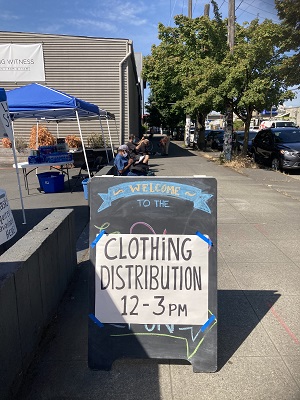
As we saw the need for community support increase, we were eager to re-open our doors, but it became obvious that it would be unwise to attempt to offer our services in the same way we always had. The infection numbers among people who were unhoused were trailing the numbers of the housed community by about 2-3 weeks, and we were concerned about being a place that would become a vector for spreading the coronavirus by drawing people together who weren’t already congregating. So we got creative. It had been about two weeks since people had been able to get clothes from us, which is a long time when a person only has 1-2 sets of clothes and no way to wash them.
We realized that we could use our answering machine as a hotline, where people could call in and leave messages listing what they needed; we could then get in contact with them to arrange a pick-up or delivery. If they had needs that weren’t in our inventory, we used Facebook and our network of friends to crowdsource them. Josh canvassed the neighborhood taking “orders” from people who didn’t have phones to call in. Jenn continually had her van filled with furniture to deliver, since we saw 5-6 of our neighbors get housing! But as we settled into this new normal, we had discussions about how this wasn’t the most effective way to distribute resources as some people were hard to track down for delivery. Also, the method of giving people whatever items we had chosen for them wasn’t prioritizing our values of dignity and agency as we had when we held open hours. It felt transactional and somewhat paternalistic for us to choose things for people to wear, rather than offering opportunities to pick for themselves what they might like.
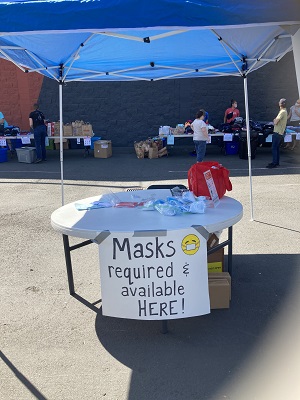
Yet donations continued to generously come in. Suddenly we had the brand new problem of having too much stuff. Back in the days of “open hours” we would serve 60-80 people a week, thus, men’s pants were rarely stocked. Now we had three full bins. Carrie, our associate director of operations, suggested a parking lot clothing distribution event, but instead of at our current location where the logistics of such an event weren’t feasible, we would hold the event in our own Quest church parking lot. I responded with what has become my mantra during this weird time we’re in: “Let’s try it!”
We would be going old school. The Bridge Care Center got its start as “To The Streets.” Members of Quest church would bring boxes full of clothing to a grocery store parking lot and engage with our neighbors who lived outside. The ministry grew, moved into a building, and even changed its name, but now we were going to go back to our roots!
We spent three weeks preparing for the event, with Carrie anticipating every detail. We thought through safety protocols, limiting exposure, and helping people feel safe and known. We were a little anxious, wondering if anyone would show up. And then we got a phone call from the King County Health Department because they’d heard about our event and wanted to know if people needed referrals–they had been interacting with a lot of people who needed clothes and wanted to send them our way. We realized we would need more volunteers.
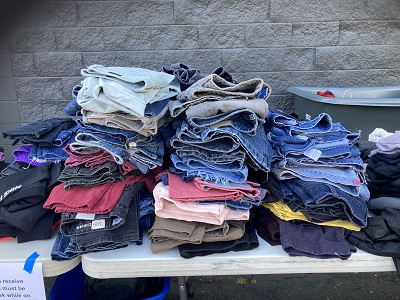
When the day came, we had plenty of volunteers to help. They set up a charging station with socially distanced chairs and power strips so people could power up their devices while waiting. We put out chairs six feet apart for the waiting line. The word had gotten out, and we had a line down the block by 15 minutes before “open.” We had asked specifically for cases of water bottles and new underwear to be able to hand out, and our Quest family came through donating 12 cases of water and 322 pairs of underwear! We were able to hand out cold water to the folks waiting in line and have conversations with them as they waited. Josh was our welcome guy, and talked people through the process. He also took that chance to share some information on participating in the census, as we’re working with an organization that’s trying to get people who live outside accurately counted and represented in our state. From that point, our neighbor would meet their “personal shopper” to go find some clothes! Having fewer people touch fewer things seemed like the right thing in the time of COVID. It turned out to be something that emulated our values of dignity and agency, allowing our personal shoppers to get to know each person, talking about needs and preferences, holding up different items, and being that friend that’s a sounding board when you’re shopping. We stood six feet away but still walking beside them, and got to hear a bit about how they were doing during this difficult time. As we heard about needs beyond clothing, we’d bring them over to Jenn, to connect them to other organizations and resources or address their need later in the week. We had a great mixture of seeing people we knew, and also getting to know people who were new to us.
When all was said and done, we were able to share resources with 82 people that day. It was an encouraging day all around, and our staff and volunteers felt energized by being able to connect with people once again, to hear their stories, and meet tangible needs. It was only about 15 minutes into the event that one of the staff said to me, “We should do this again, maybe every month.” And of course my response was, “Let’s try it!”
[Click Here] to visit the Bridge Care Center Website
